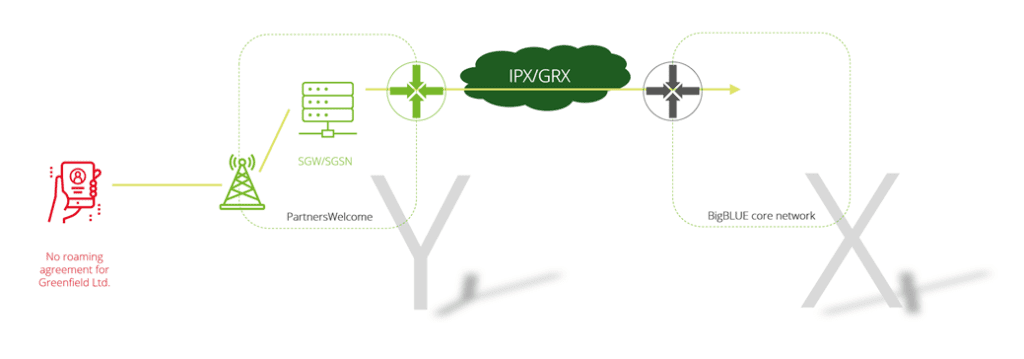Monetize your roaming partnership agreements
jtendo GTP Proxy has been gaining a lot of attention since its initial release. It was designed to address numerous challenges faced by mobile network operators (MNOs) in effectively managing and routing the still-growing GTP traffic in their network. This solution can be seamlessly deployed on any mobile network interface where GTP protocol is used. The number of technical and business problems it addresses is constantly increasing.
In this article we will focus on one of the most popular services we are proud to build, broadly known as Sponsored Roaming or Sponsored IMSI allowing customers to monetize their investment in jtendo GTP Proxy.
Understanding Sponsored Roaming
Since Sponsored Roaming service has emerged with and benefits from Multi-IMSI SIM cards and , an introduction to it requires at least a few words on that technology.
Multi-IMSI SIM allows to bootstrap multiple IMSI numbers into single SIM card, so it can be used to connect to multiple network operators. This technology offers significant advantages, particularly for IoT devices, ensuring uninterrupted connectivity by seamlessly switching to alternative IMSIs when the home network’s coverage is unavailable. Additionally, small, or new MNOs can leverage Multi-IMSI SIM technology to expand their global reach by accessing international roaming agreements with other MNOs.
What is more, large MNOs can take advantage of Multi-SIM by offering high-quality roaming coverage worldwide as a B2B sponsored roaming service to small M(V)NOs and IoT service providers.
Illustrating the Sponsored Roaming Solution
To illustrate the Sponsored Roaming solution, let’s introduce the key actors involved:
- IMSI Sponsor – BigBLUE Telecom – Large renowned domestic operator with recognized market position and roaming agreements worldwide.
- IMSI Sponsoring customer – Greenfield Ltd. small local operator with decent network coverage across the country, who has just begun the process of establishing roaming agreements with MNOs abroad, hence its roaming coverage is limited.
BigBLUE Telecom and Greenfield Ltd. offer their mobile services in Country X.
- Roaming Partner – PartnersWelcome Telecom – One of BigBLUE Telecom roaming partners offering mobile services in Country Y.
- Alice – lives in country X and is a happy customer of Greenfield Ltd.
This year Alice has decided to go on vacation in country Y and expects all her mobile services offered by Greenfield Ltd. to be available there. Greenfield Ltd. has anticipated this and signed Sponsored Roaming agreement with BigBLUE Telecom in advance. Furthermore, Alice’s Mobile handset is equipped with Multi IMSI SIM bootstrapped with IMSIs of both these operators.
Upon arrival at the airport in Country Y, Alice disables airplane mode on her mobile device, prompting it to scan for available networks. None of the networks let her Greenfield’s IMSI connect due to the lack of roaming agreements. At this point Secondary IMSI belonging to BigBLUE Telecom is activated and attached to PartnersWelcome Telecom. The latter one recognizes the IMSI as belonging to BigBLUE and routes its requests from SGW/SGSN through its IPX/GRX provider to BigBLUE core network.

The Crucial Role of jtendo GTP Proxy in Roaming Management
Up to this point, Alice’s secondary IMSI is treated like any other customer of BigBLUE roaming from abroad. It is now up to the operator to filter out those packets and manage them according to the agreement with Greenfield Ltd. The effort to do so is not easy, since the volume of roaming traffic in the BigBLUE core network is high, and there is no out-of-the-box solution that would address it.
Recognized for its commitment to providing the highest quality of service, BigBLUE Telecom has partnered with jtendo to deploy the GTP Proxy in its core network. This strategic partnership empowers BigBLUE to overcome the challenges associated with filtering and managing Sponsored Roaming traffic effectively.
jtendo GTP Proxy can be deployed on the GTP interface between the Home Public Land Mobile Network (HPLMN) and the Visited Public Land Mobile Network (VPLMN), efficiently processing GTPv1 and GTPv2 control-plane and user-plane traffic. It offers two deployment modes, each catering to specific requirements:
- Transparent Mode: This mode offers unparalleled convenience for MNOs as it eliminates the need for additional public IP addressing. MNOs can seamlessly integrate the GTP Proxy into their existing core network infrastructure without requiring configuration changes in surrounding core network elements or requesting modifications from roaming partners worldwide.
- Regular Mode: In this deployment mode, the GTP Proxy acts as a termination point for the GTP tunnel. It analyzes the content of messages and applies preconfigured logic to determine the appropriate actions. From the perspective of the Packet Data Network Gateway (PGW)/Gateway GPRS Support Node (GGSN), the GTP Proxy functions as a Serving Gateway (SGW)/Serving GPRS Support Node (SGSN), ensuring comprehensive control and management of the GTP session.
When it comes to working modes, jtendo GTP Proxy can apply any of below three concurrently, depending on various conditions, like IMSI range, APN, or source IP address:
Relay mode
- Used when only routing function of GTP sessions is needed – GTP Proxy selects the target GGSN/PGW based on the configuration or/and GTP-C messages.
- GTP Proxy carries out only the exchange of session initiating GTP-C messages.
- No IP addresses are replaced by the platform inside GTP messages, thus the following GTP communication goes completely beyond the platform.
- The simplest solution for GTP contexts/sessions load-balancing/routing.
- The modification of initial GTP-C requests is also possible (APN, QoS, etc.).
- The least resource-intensive mode.
- Requires direct network connectivity/routing between source and target networks (SGSN/S-GW and GGSN/P-GW).

Half-Proxy mode
- Used when full control of the GTP session signaling is required.
- GTP Proxy carries out all GTP-C messages between SGSN/S-GW and target GGSN/P-GW.
- Control plane (GTP-C) IP addresses are replaced by the platform inside GTP messages, thus complete GTP-C communication goes through the platform. The GTP-U related IP addresses are not modified.
- The mode enables much more control than the Relay Mode – enables GTP-C message translation/modification passing through the platform during the lifetime of the GTP session.
- Hides the GTP-C path topology (by replacing the target GGSN/P-GW IP addresses the SGSN/S-GW does not “see” the target node).

Full Proxy mode
- Used when full control of the GTP session is required (both GTP-C and GTP-U).
- GTP Proxy carries out all GTP messages between SGSN/S-GW and target GGSN/P-GW.
- Control plane (GTP-C) and User plane (GTP-U) IP addresses are replaced by the platform inside GTP messages, thus complete GTP communication goes through the platform.
- The mode enables higher control than the Half-Proxy Mode.
- Completely hides the GTP topology – SGSN/S-GW “sees” only the GTPX node – might be the only solution for deployments when the target GGSN does not have the direct path (routing) to SGSG/S-GW network.
- Resource demanding – proxying GTP-U traffic requires high CPU resources.

To control GTP tunnels (for signaling and/or user plane) the GTP Proxy platform follows contexts activation and deactivation and stores all information needed for traffic throughout the GTP context lifetime.
Some of most used conditions (but not the only ones) that can be checked on each single context are:
- Determining the IMSI range.
- Mapping IMSI range to profile configured in the platform.
- Detecting the origin of the request (originating network).
- If the location information (MCC+MNC) of the originating network (SGSN/SGW) is not present in the initial request, it can be determined based on the IP address of the requesting node.
And actions based on above:
- Selecting the working mode (from the ones described above).
- Selecting QoS profile.
- Making additional dip. e.g., to HSS in HPLMN to retrieve online and offline charging information and pass it to PGW.
- APN translation
- APN translation table can be configured in GTP Proxy which is used to translate APN from the request into configured value:
- temporarily (just for APN DNS query)
- permanently (replacing APN value in the forwarded GTP message)
- APN translation table can be configured in GTP Proxy which is used to translate APN from the request into configured value:
Unlocking Possibilities: Building Custom Services with jtendo GTP Proxy
The comprehensive tools and modes offered by jtendo GTP Proxy empower Mobile Network Operators (MNOs) to create a range of concurrent services tailored to their specific needs. These services can be extended to business partners or even individual subscribers, opening up new avenues for revenue generation and enhanced customer experiences.
Let’s revisit Alice’s case and see how BigBLUE utilized the potential of GTP Proxy to resolve her problem.
As mentioned earlier, Alice expects all her mobile services provided by Greenfield Ltd. to be available while she is on vacation abroad.
To meet this expectation, BigBLUE uses a specific subrange of IMSI numbers that are bootstrapped on Greenfield Ltd. Dual IMSI SIMs.
That range is also preconfigured on GTP Proxy, so whenever initial GTP-C request arrives there, the solution recognizes it and applies following actions according to the agreement with Greenfield Ltd:
First, GTP Proxy applies Full Proxy mode, and terminates GTP-C and corresponding GTP-U tunnel for all packets received from PartnersWelcome Telecom for Alice’s IMSI.
At the same time, it modifies the APN to the one Greenfield Ltd expects and takes a dip into DNS to obtain the IP address of the Greenfield Ltd core network element that will handle Alice’s traffic.
Finally, the solution sets up corresponding GTP-C and GTP-U legs to Greenfield Ltd Core Network.

This example highlights the flexibility and power of jtendo GTP Proxy, allowing MNOs to create personalized services that cater to specific requirements. The solution’s ability to dynamically adapt and apply various actions based on conditions such as IMSI range, APN, or source IP address enables MNOs to provide their customers with enhanced roaming experiences. MNOs can create innovative offerings that differentiate them in the market. Whether it’s enabling seamless connectivity for travelers, facilitating IoT device management, or optimizing service quality for specific partners, the GTP Proxy unlocks endless possibilities for revenue growth and customer satisfaction.
In conclusion, by harnessing the capabilities of jtendo GTP Proxy, MNOs can unleash their creativity and develop services that deliver exceptional value to their customers and partners. As the telecommunications landscape continues to evolve, the adaptability and efficiency of the solution will remain essential in meeting the dynamic demands of the industry and staying ahead in a highly competitive market.





